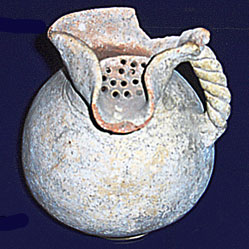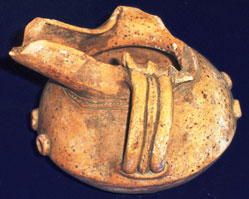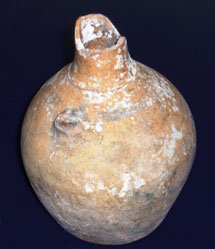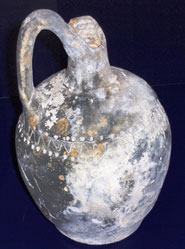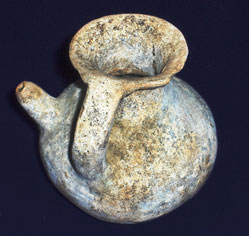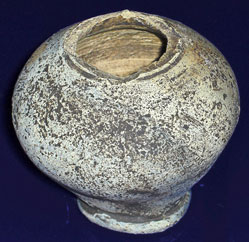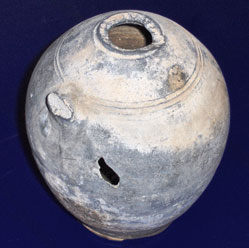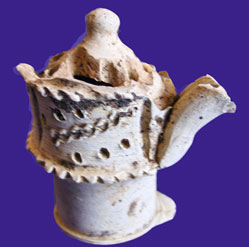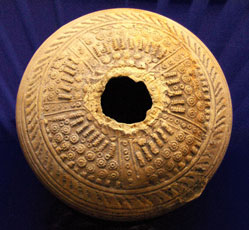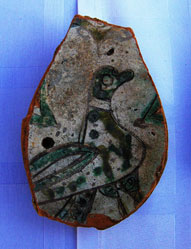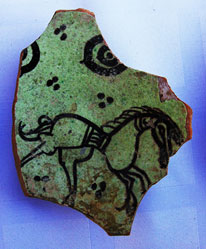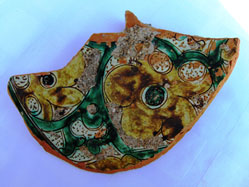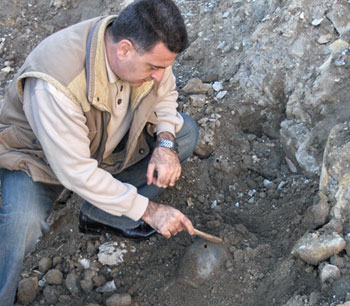New archaeological finds in the Old City (Icheri Sheher)
Pages 48-56
by Dr. Kamil Ibrahimov
Azerbaijan´s history is chronicled in stone in Baku´s Old City, a unique example of medieval urban architecture. The city provides invaluable information about Azerbaijan´s history and culture and merits more research. It is our duty to preserve this unique stone city for future generations. The demolition of houses on Neftchiler Ave, M. Magomayev St and I. Magomayev St in the southwest corner of the Old City in 2007 to make room for the Horizon Hotel meant that archaeological work could be done at this site.
Historically valuable finds were made in four months of survey work and two months of archaeological exploration by the Scientific and Research Division of the Cabinet of Ministers´ Department for the Preservation of the Old City. These finds allow new interpretations of Baku´s history.
Pages 48-56
by Dr. Kamil Ibrahimov
Azerbaijan´s history is chronicled in stone in Baku´s Old City, a unique example of medieval urban architecture. The city provides invaluable information about Azerbaijan´s history and culture and merits more research. It is our duty to preserve this unique stone city for future generations. The demolition of houses on Neftchiler Ave, M. Magomayev St and I. Magomayev St in the southwest corner of the Old City in 2007 to make room for the Horizon Hotel meant that archaeological work could be done at this site.
Historically valuable finds were made in four months of survey work and two months of archaeological exploration by the Scientific and Research Division of the Cabinet of Ministers´ Department for the Preservation of the Old City. These finds allow new interpretations of Baku´s history.
Fortress wall foundations
The archaeological excavations revealed part of the foundation of Baku´s south-west fortress wall, built in the 12th century (1138-39). The foundation of limewater and stone was found approximately six metres deep. The main building material in Shirvan-Absheron architecture was local stone – limestone (badamdam). Archive documents reveal that the south-west walls of the Old City fortress were destroyed in the late 19th and early 20th century during work to prepare the ground for new buildings. Stones from the fortress walls were used as building materials.
When the excavations reached a depth of four to five metres, they were flooded with ground water. Water pumps had to be used and the area drained before the excavation could continue.
Ceramics
The archaeological finds date back to the 9th to 17th centuries. They are mainly fragments of pitchers, jugs, cooking pots, lamps, water pots, jugs with a lip for drinking juice or wine, polychromatic (colourful) and monochromatic plates, bowls, stoneware and farm utensils. Ceramics were a large part of the finds. Most of the colourful glazed ceramics are richly decorated inside - through painting, engraving or other techniques. Some are covered with a layer of a manganese-mixture glaze. Most of the glazed polychromatic and monochromatic crockery found is decorated with pictures of animals and birds. These dishes date back to the 11th to 13th centuries. Examination of the finds has shown that the production of glazed ceramics was advanced in medieval Baku. Baku was rich in the fuel and clay required to produce ceramics and became a centre of ceramics production.
Archaeological excavations over a long period of time in the Old City have found plenty of painted, glazed, unglazed, china, faience and celadon ceramics. They are mainly domestic utensils - dishes for the kitchen and food storage pots. Ceramics can be classified according to their method of production and purpose. The recent finds in Baku can be divided into unglazed, painted, faience and glazed earthenware. They include jugs, lamps, pitchers, amphorae, candlesticks, clay jars, basins, water pots, tea-pots and lids.
The ceramics from the early Middle Ages and earlier are of great interest. An ancient clay pot was found in a well eight metres deep. Fragments of another ancient vessel were found one metre deep inside this well. This jug is made of white clay mixed with fine sand. It has a filter at the top, a wide collar at the neck and broad lip for pouring. It is typical of ceramics from the 4th to 1st centuries BC. Its handle is made of twisted strands. The jug has two decorative lines below the neck. It is clearly hand-made. Similar jugs have been found in sites belonging to the Yaloylutepe culture (4th to 1st centuries BC)1. A similar clay jug was found in the upper courtyard of the Shirvanshahs´ Palace in 1946 during B.N. Leviatov´s excavations2. The jug is now kept at the Hermitage in St Petersburg. F. Ibrahimov found another similar jug in 1985 at the site of the former jewellery workshop in the 24th excavation area3. An ancient double tomb was found in that area too and seems to have been connected to fireworship. One of the painted jugs found there also has a guttered lip for pouring. These jugs are known to have been widespread in antiquity and are typical of the Yaloylutepe culture4.
Ceramics from the Yaloylutepe culture differ in type. Much has been written about the one handled "milk jugs". While one side of the rim is folded inwards, the lip is open. The outside of the jugs is decorated with geometrical lines, clay medallions and other ornamentation. One type of these jugs has several lips, a filter on the left and a spout opposite the handle. Unlike the previous jugs, the jugs with several lips are painted red and decorated with lines and engraving. Researcher D. Sharifov divided these jugs into two types, black and light grey. He thinks that the light grey jugs belonged to incoming tribes and the black ones to local people. These jugs were used to hold water or wine5.
Another ancient find (2nd to 1st century BC) is a small, painted water or wine pot with a wide handle, double spout and filter. The pale red, hand-made water pot has eight decorative round mouldings on its body. These are symbols of the Sun. The lower part of the neck and middle of the handle are decorated with tracing. Many such clay vessels have been found in other ancient sites in Azerbaijan.
Two similar vessels from this culture, which was widespread in the South Caucasus, are on display at the Archaeological Museum in Tbilisi6.
The number of red pots increased in Baku from the 3rd century BC. A new kind of jug, similar to a milk jug but with a long spout, is evidence of the development of fruit-growing7.
The painted pots are distinctive in terms of the composition of their clay, their purity and their baking. Most of these coloured vessels were delicately made and decorated on the outside with symmetrical, wavy, broken lines, circles, triangles, rhombi, tracery, various geometrical and botanical designs and images of the heavenly bodies. Images of the Sun, Moon and sky are linked to worship of the heavenly bodies. Such images engraved on domestic items, buildings and tombstones in the Middle Ages have a religious meaning. Images of the Sun were not merely used as decoration in the Middle Ages; the use of such images on religious monuments shows that ancient belief concerning the heavenly bodies had survived into this period.
Another group of coloured vessels are painted red or decorated with red patterns.
Coloured vessels were widespread in the late Bronze and Early Iron Ages and the traditions continued into the Middle Ages.
The small water and wine jug found in the excavation area has an original shape. The wide ribbon-like handle merges with the spout and is folded back to the sides. The clay is mixed with coarse sand and well baked, which has given it a grey colour. The jug has a 5-cm long, oblong spout in the middle of its body. The hand-made water jug is designed for personal use. Comparison with similar jugs dates it to the 1st century BC. Clay water or wine pitchers were widespread in Azerbaijan in antiquity. They must have been in great demand among the Baku population. The ancient trade routes played an important role in spreading eastern culture to the west and north. One of the main trade routes passed along the Caspian Sea coast. These links and cultural influences can be seen in Baku ceramics. Strabo writes that many goods were sent down the Oxus (Amu-Darya) River and across the Gurgan or Caspian Sea to Caucasian Albania and across the Pontus (Black) Sea to other countries.8 Ancient authors show that the south of Azerbaijan was in a favourable location for transport in antiquity9. Baku also played an important role as a residential place. It is likely that the excavated items were brought to Baku via the trade routes.
Another small, jug-like pot with a broken neck and top was found in the excavations. This pot was simply made with the base having been stuck onto the body. The jug is made of clay mixed with fine sand. It has been well baked and acquired a dark grey colour. The pot, found at a depth of eight metres, dates back to roughly the 1st century BC.
Another water jug has a relatively large body and long neck. Its clay has been mixed with fine sand, well baked and is a dark blue. The lower part of the handle is decorated with parallel dotted lines and spiral patterns, a sign of infinity. The pot is hand-made and has spots on the outside. This jug-like water pot dates back to the to the 2nd to 3rd centuries AD.
A jug-like water pot with a single handle made of white clay (kaolin) is also of great interest. This pot dates back to the 3rd to 4th centuries AD. One of the water-pots from late antiquity (3rd to 4th centuries AD) found in the Old City has thick sides and an unusual shape. Three straight lines encircle the body of the pot.
The single handle and long neck of another clay pot are broken. The clay of the pot was mixed with coarse sand and well baked and is pale red. The lower part of the body and neck has a border of straight lines. Similar pots date back to the early Middle Ages - approximately to the 5th to 6th centuries AD.
Flasks
A rare find in the Old City excavations is a yellow-clay, decorated mehtere (flask). The outside of the flask is decorated with convex circles10. The medallion is decorated with a complex layer of intersecting lines. The lines create a shape similar to the swastika (a very old religious symbol in which a cross-like Sun has four corners bent into a rectangle). The solar patterns are completed with flames between engraved circular lines. This flask dates back to the early Middle Ages - roughly to the 5th to 6th centuries AD.
Many earthenware flasks of different shapes, with protruding bellies and rich moulded decorations, have been found at the Old City site11. Many fragments of flasks have also been found. Unlike the patterns on pitchers mentioned above, shallow, small-diameter moulds, reminiscent of salt cellars without any holes, were used to make the decorations.
A ceramic flask found in the Old City in 1970 has an original decoration on the inside. A medallion, 8.5-cm in diameter, is fastened to the outside of the body and decorated with moulded patterns12.
A ceramic flask found in a temple near the Maiden Tower in 1964 bears a medallion, cast in a mould, decorated with a circle divided into eight sections. In the centre of the medallion is an eight-point star inside a square inside a small circle. The stars and space between them are convex. A two-handled flask made of red clay, decorated on the outside with a convex medallion, was found in one of the Old City´s residential quarters in 1971. The design is very artistic, with clear lines. The design covers the whole circle and resembles a heartshape or complex trefoil. Traces of a crown can be seen among the trefoil shapes.
Many fragments from the bodies and bases of polychromic, glazed plates and jugs of various sizes from the 12th and 13th centuries have also been found13. Most of these dishes bear the stamp of the craftsmen on their base.
A large quantity of animal bones has also been found at this excavation site. They include the remains of camel skulls and gazelle antlers. The antlers have clearly been carved.
Metal and stone items
Two metal items have been found at the excavation site. One of them is made of copper and resembles a small bowl. It has a lid. The other one is a fragment of a different metal. Since these metal remains were found at a depth of seven metres, they may belong to the early Middle Ages.
Many interesting examples of stonemasonry have been found at the site. One of them is a rectangular gravestone, weighing 300 kg, which has an ornamental frieze on its front and sides. The stone is intact on one side but broken on the other. Five small circles inside a larger circle, similar to the Sun symbol, have been inscribed on one side. There was an ancient cemetery near the spot where the stone was found. Since the stone was found near the fortress walls, it probably dates back to the 12th century.
Another rectangular stone monument is the central part of a column. It has three, long, rectangular carvings on the outside. Incomprehensible signs have been engraved on top of the carving. Holes were made to fasten the piece to the base and top (capital) of the column. The column is from the Middle Ages.
An example of the base of such a column was found during excavations in 1964.
Another stone column base was found in 1988 during excavations of the ground floor of the Muhammad mosque.14 The only difference between this limestone base and the other one is the circular cross section. The two finds were made at the same depth, 15-20 metres apart.
Columns were widely used in the facades and interiors of buildings in ancient eastern architecture. Similar stone columns and bases have been found in Azerbaijan´s ancient and early medieval cities - Shamakhi, Qabala and Derbend.
Another gravestone was found at a depth of nine metres at the excavation site. The sides of this rectangular stone are decorated with a frieze while the top is engraved with a tree of life between two fish looking up and sun designs. Patterns are engraved on the top of the stone. The gravestone probably dates to late antiquity (4th to 6th centuries AD).
Fish - symbol of abundance and prosperity
Many fish shapes and items decorated with a fish design have been found in excavations in the Old City over the years.
A fantastic bronze fish, found near the Maiden Tower at a depth of 2.2 metres in 1964, shows that the city is an ancient place of habitation. The fish is 8.2 cm long, 4.5 cm high and 0.7 cm thick. Its eyes are made of protruding buttons and its ears also protrude. Behind the ears are wings. The body is covered with thick scales and the tail folded in a hook shape15.
Such fish are not found in the medieval and later period. Images of fish were scratched onto the Gobustan rocks in the 10th- 9th millennia BC. In Zoroastrianism the image of the fish was an incarnation of the divine. The goddess of water Anahita had the form of a fish. The image of the fish is found on the facades of houses in Absheron and on coins minted by the Shirvanshahs in Baku. People see it as an ancient tradition. Absheron people interpret dreams about fish as a sign of wealth. Fish were clearly an ancient totem in Absheron and were an embodiment of the god of the sea. Sara Ashurbeyli writes that the fish was also considered a symbol of abundance and prosperity in this area. The preponderance of images of fish carved onto the Gobustan rocks show that fish were part of daily life and that belief in them began in antiquity16.
The image of a fish on the headstone found in the Old City indicates that the stone dates back to antiquity or an even older period.
Fragments of a glazed cup found at the bottom of a 12th century stratum have the image of a fish inside. The fish has the shape of a leaf and its scales are narrow, criss-cross strips that make square and rhomboid shapes. The stamp on the base of the bowl is not clear. The vessel probably dates from an even older period17.
One of the stone items found at a depth of nine metres at the excavation site is rectangular and has a small hole at the bottom of the larger side. It has two possible functions. The first is as a tool. It would have been used to squeeze juice out of grapes in late antiquity when wine-making developed. The second possibility is that it was a lavatory stone. The structure of the stone implies that it could have been used as a lavatory in the early Middle Ages (8th to 9th centuries AD). It was the first time such an interesting stone had been found in the Old City.
The archaeological finds made the during recent excavations in the Old City show that the first inhabited area on the Caspian Sea coast was Baku bay. Classification of the new finds confirms that Baku, a centre of Azerbaijan in different forms from ancient times until our day, was a densely populated area.
About the author: Dr Kamil Ibrahimov, is a senior researcher at the Azerbaijani National Academy´s Archaeology and Ethnography Institute. He is the head of the Baku archaeological expedition.
LITERATURE
1. R.B. Goyushov, Azerbaycan Arxologiyasi (Baku, 1983), pp. 81-95
2. V.N. Leviatov, Arkheologicheskiye raskopki 1946 v krepostnoy chasti gor (Baku, Publishing House of the National Academy of Science of Azerbaijan SSR), pp. 120-130
3. F.A. Ibrahimov, 1986-ci ilde Icheri Sheherde aparilan arxeoloji qazintinin hesabati (Scientific Archive of the Azerbaijani National Academy´s Archaeology and Ethnography Institution, collection 1, case 1986/0-19), pp. 6-14, 19
4. F.A. Ibrahimov, Icheri Sheherin son tapintilari, Elm ve heyat (Sience and Life) magazine, (Issue 5, 1985)
5. R.B. Goyushov, op.cit., p. 90
6. Kultura Yaloylu-tepe v Zakavkazye, Aspirants´ collection, vol. 1, State Academy of Material Culture History (Saint-Petersburg, 1929), pp.34-36
7. Azerbaycan maddi medeniyyeti , vol. 6 (Baku, 1965), pp. 241, 250
8. Strabo, Book 9, 3 (in Russian), translated by G.A. Stratonovskiy (Moscow - Saint-Petersburg, 1964), p. 480
9. Azerbaycan maddi-medeniyyeti, vol.10 (Baku, 1987), p. 69
10. F.A. Ibrahimov and K.F. Ibrahimov, Baki Icheri Sheher (Vol.1, Baku, 2002), pp. 57-63
11. Ibid.
12. K. Farhadoglu, Baki Icheri Sheher (II vol., Baku, 2006), p. 220
13. K. Farhadoglu, Icheri sheher Qorugu erazisinde yeni ashkar olunmush Bakinin qedim dovr tarixine aid maddi-medeniyyet numuneleri (Baku, 2007), pp. 16-17
14. Ibrahimov F.A. Icheri Sheherde 1988-ci ilde arxeoloji qazintilar, conference proceedings (Baku, 1992), p. 9
15. O.Sh. Ismizade, H.A. Jiddi, Baki Qiz Qalasi (Baku, 1968), p. 20
16. S.B. Ashurbeyli, Istoriya qoroda Baku (Baku, 1992), p. 29
17. F.A. Ibrahimov and K.F. Ibrahimov, op. cit., p. 88
